Archive for February, 2015
Iiro Küttner & Ville Tietäväinen: Puiden tarinoita: Puuseppä [Tales by trees: the carpenter]
26 February 2015 | Mini reviews, Reviews
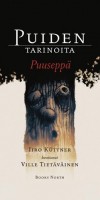 Puiden tarinoita: Puuseppä
Puiden tarinoita: Puuseppä
[Tales by trees: The carpenter]
Kuvitus [Ill. by] Ville Tietäväinen
Helsinki: Books North, 2014. 30 pp., ill.
ISBN 978-952-67980-5-9
€28.90, hardback
The picture book surprise of the year is Puuseppä, the first book in the Tales by trees trilogy, launched with fanfare by Books North, a new small press, and extremely polished in appearance. The story pays homage to the classic tales of Zacharias Topelius and H.C. Andersen. The carpenter of the story is under the special protection of the emperor, and has the time and money to make anything he wants. His chosen project is stupendous – to isolate himself for 30 years and build an enormous tree, using various types of wood and complicated construction techniques. He forgets his family and finally wears himself out in the process. The story closes with a sly moral reflective of Finnish contemporary society, about forced labour, the pressures of working life, and the value of work. Comics artist Ville Tietäväinen’s illustrations are tactile – the picture of tree rings makes you want to touch it and feel the rough texture of the cut wood. Books North is an offshoot of Agency North Oy, which specialises in promoting Finnish drama and film abroad.
Translated by Lola Rogers
Timo Parvela: Paten aikakirjat [Pate’s chronicles]
26 February 2015 | Mini reviews, Reviews
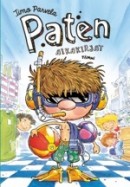 Paten aikakirjat
Paten aikakirjat
[Pate’s chronicles]
Kuvitus [Ill. by]: Pasi Pitkänen
Helsinki: Tammi, 2014. 96 pp., ill.
ISBN 978-951-31-7800-0
€25.90, hardback
Timo Parvela has achieved acclaim and won readers both in Finland and abroad – in Germany in particular. His Maukka ja Väykkä (Purdy and Barker) series of children’s novels will also soon be published in Great Britain. The Ella series for beginning readers now includes no less than 17 books, and now Pate, one of Ella’s supporting characters, has got his own series. The international counterpart of Paten aikakirjat – abundantly illustrated by Pasi Pitkänen – might be someone like Jeff Kinney, illustrator for Diaries of a Wimpy Kid. After living aborad for many years, Pate’s Uncle Pentti makes a bustling entrance into Pate’s life. Timo Parvela delights as usual with his trademark contrasts between children and slightly weird adults. In between comic mishaps are tons of easy-to-read dialogue, comics and lists of silly things.
Translated by Lola Rogers
Holy book
26 February 2015 | In the news
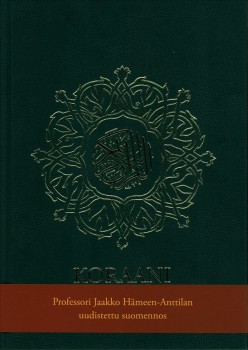
The Koran, Koraani, translated into Finnish by Jaakko Hämeen-Anttila.
In an unprecedented project, the Koran, the holy book of Islam, is to be read on the Radio 1 channel of the Finnish Broadcasting Company (YLE) in 60 half-hour segments. Made with considerable input from the Finnish Muslim community, the series is not, however, part of YLE’s religious broadcasting, but is intended to increase people’s knowledge of the Koran and Muslim culture in general.
‘It is important that the Koran is read in its entirety, and not just select items that show that Islam is bad and violent or good and beautiful,’ says the translator, Professor Jaakko Hämeen-Anttila. The broadcasts are to be preceded by conversations between Professor Hämeen-Anttila and Imam Anas Hajjar, a leader of the Finnish Muslim community, exploring the religious and historical context of the day’s text. According to Hämeen-Anttila, the two men discussed ‘everything between heaven and earth’ during the recordings. Among other things they consider the role of Satan, instructions on suitable behaviour for men when in the company of women, and the Ayat an-Nur, or ‘Verse of Light’, an Arabic text found on the wall of many Muslim homes.
Islam, numbering an estimated 40,000 believers, is a minority religion in Finland, whose two official denominations are the Lutheran and Greek Orthodox churches. The first Muslims to come to Finland were Tatars from Russia in the 19th century; most, however, arrived after 1990, mainly from Africa and the Middle East.
‘The programme is an important step in understanding one another. It is an attempt to tell the story of The Koran and what it contains,’ says Imam Hajjar.
The series begins on 7 March.
New from the archives
19 February 2015 | This 'n' that

Jarkko Laine. Photo: Kai Nordberg
Our archive find this week is ‘The 101 year anniversary celebration’, a short story by Jarkko Laine.
‘Child of Marx and Coca-Cola’, ‘Nordic beatnik’, Jarkko Laine (1947-2006) published his first work, a volume of poetry entitled Muovinen Buddha (‘Plastic Buddha’) in the 1960s and was immediately hailed as the mouthpiece of his generation. He went on to make his career as a literary all-rounder – poet, writer, playwright, translator, long-time editor of the literary magazine Parnasso and chair of the Finnish Writers’ Union. His wryly ironic story, ‘The 101 year anniversary celebration’ tells the story of what every writer must dread: a guest appearance in a local library where literature from the local town, let alone further afield, is regarded with suspicion.
We’ve also unearthed a 1989 interview, by our late, genial editor-in-chief Erkka Lehtola with a grey-suited Laine who looks more like a civil servant than a 1960s radical – but still doesn’t let a day go by without writing.
*
The digitisation of Books from Finland continues apace, with a total of 360 articles and book extracts made available online so far. Each week, we bring a newly digitised text to your attention.
New from the archives
19 February 2015 | This 'n' that
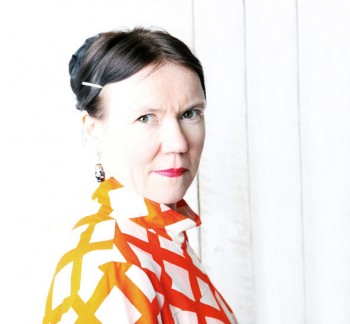
Rosa Liksom. Kuva: Pekka Mustonen
When the pseudonymous Rosa Liksom (born 1958; real name Anni Ylävaara) burst on the Finnish literary scene in 1985 with her first book, Yhden yön pysäkki (‘One night stand’), excitement was intense. For a start, she managed to keep her real identity secret, even when she appeared at public events and book-signings; then, she wrote generally in her native northern Finnish dialect, which hadn’t previously been heard very much in literary circles. Her very short short prose charted landscapes also not much represented in literature – the far north, the uneducated, the dispossessed.
This group of seven stories, from her second book, Tyhjän tien paratiisit (‘Paradises of the open road’, 1989), cover territory which has become familiar in her work: a woman who marries a layabout, a bellicose butcher’s son, a cleanliness fanatic for whom hygiene is more important than human relationships….
Rosa Liksom won the Finlandia Prize in 2011 for Hytti nro 6, which was published by Serpent’s Tail, London, in a translation by Lola Rogers last year.
*
The digitisation of Books from Finland continues apace, with a total of 360 articles and book extracts made available online so far. Each week, we bring a newly digitised text to your attention.
Not joined up
19 February 2015 | In the news

Photo: Brad Flickinger / CC BY 2.0
The news that Finnish schools are to stop teaching cursive writing, in favour of a new emphasis on touch typing and the most efficient way of composing a text message, has been widely reported in the British press.
But not in our household.
With three children – aged 13, 9 and 6 – all struggling, to a greater or lesser degree, to make sense of the curlicues of joined-up writing as it’s taught in British schools, the pressure to abandon school in London and move to Finland would be all but irresistible if they every got to hear the news.
With letter-forms that bear little resemblance to printed characters and a loopy style, apparently derived from old-fashioned copperplate, that few children are going to be able to master completely, let alone develop into an elegant mode of handwriting, joined-up handwriting remains for many an obstacle to, not a means of, communication.
Added to the benefits of Finnish schools my children already know about – the shorter working days, the lighter homework load, the absence of school uniforms, the good school meals, the outdoor breaks every hour – the news that not only will Finnish schoolchildren not be expected to develop good handwriting, but will be issued with tablets on which to practise their computer skills, would axe their enthusiasm for school at home in Britain.
For their mother, the puzzle remains how Finland manages to employ such child-friendly school policies and still remain close to the top of the global Programme for International Student Assessment (PISA) assessments. The trick seems to be to recruit top-level graduates into well-run teacher training schemes, pay them well, and to trust them to do their job as teachers, without the mounds of paperwork and need for incessant testing that bedevil the job in Britain.
About the handwriting, my children will find out soon enough, when their friends in Finland come home carrying not exercise books but tablets.
But meanwhile, I’m keeping my fingers crossed they don’t see this piece.
New from the archives
19 February 2015 | This 'n' that

Tua Forsström. Photo: Mao Lindholm
Some weeks the digitisation project turns up material we’ve all but forgotten about; other times it’s like greeting an old friend. The poet Tua Forsström’s voice belongs in the second category: quintessentially feminine, wise, simultaneously vulnerable and strong, she is a quiet, watchful observer of everyday life, fixing the chimerical, the evanescent not with, it seems, but between, the words of her poems. This extensive selection of poems is introduced by her friend and fellow poet, Claes Andersson.
Born in Porvoo in 1947, Forsström publishes rarely. She won the Nordic Council Literary Prize in 1998 with Efter att ha tillbringat en natt bland häster (‘After having spent a night with horses’, 1997). Her breakthrough into the English-speaking world came in 1987 with her sixth collection, Snow Leopard (Snöleopard), which was translated into the English by David McDuff and published by Bloodaxe Books. We’ve featured her work regularly, including her most recent collection, En kväll i oktober rodde jag ut på sjön (‘One evening in October I rode out on the lake’, Söderströms, 2012), with an introduction by Michel Ekström.
*
The digitisation of Books from Finland continues apace, with a total of 358 articles and book extracts made available online so far. Each week, we bring a newly digitised text to your attention.
Hiroko Motai & Marika Maijala: Miljoner biljoner julgubbar [A million trillion Santas]
19 February 2015 | Mini reviews, Reviews
 Miljoner biljoner julgubbar
Miljoner biljoner julgubbar
[A million trillion Santas]
Translated from English into Swedish by Mirjam Ilvas
Kuvitus [Ill. by]: Marika Maijala
Helsinki: Schildts & Södersröms, 2014. 40 pp., ill.
ISBN 978-951-52-3422-3
€19.90, hardback
Miljoona biljoona joulupukkia
Suom. [Translated from English into Finnish by] Hannele Mikaela Taivassalo
Kuvitus [Ill. by]: Marika Maijala
Helsinki: Schildts & Södersröms, 2014. 40 pp., ill.
ISBN 978-951-52-3473-5
€18.90, hardback
Christmas-themed children’s books have a long tradition in Finland. Many new Christmas books appear every year to quench both children’s and adults’ Christmas fever. Japanese Tove Jansson fan Hiroko Motai (born 1972) approached Jansson’s Finnish publisher with her anarchic Santa Claus story with the hope that they would be interested in her idea. Motai’s story explains the miracle that happens every Christmas Eve: there are multiple Santas these days, because there’s no possible way that Santa could make it to the home of every child in the world in just one night. Versatile illustrator Marika Maijala has updated her image register by tightening up her earlier style. The rough chalk drawings brought to this reader’s mind drawings from her own school days. The sparse, naïve style is a excellent proof that a retro style can inspire an illustrator to create her own unique expressions.
Translated by Lola Rogers
Marja-Leena Mikkola: Helmenkantaja [The pearl bearer]
19 February 2015 | Mini reviews, Reviews
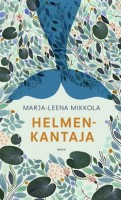 Helmenkantaja
Helmenkantaja
[The pearl bearer]
Helsinki: Otava, 2014.125 pp.
ISBN 978-951-1-28182-5
€23.90, hardback
Marja-Leena Mikkola (born 193x) has had a long career as a poet and translator. She has also written books for children and young adults, and Helmenkantaja shows her thorough familiarity with Anglo-Saxon fantasy fiction. Charles Kingsley’s Water Babies as well as H.C. Andersen’s little mermaid seem to glimmer in the background of this story. True to Mikkola’s ethos, the novel has a dose of ecocriticism in its theme of protection of a threatened pearl oyster. Reetta is fed up with looking out for her younger siblings at the family’s summer cabin; it feels as if the summer is slipping away. This everyday tale gradually breaks off into an exciting adventure in an underwater kingdom. The water boy, heir to the queen of the water, has to be rescued from the clutches of the water wizard. This difficult task requires a daredevil like Reetta, who, in additon to many other important qualities, has the gift of storytelling.
Translated by Lola Rogers
Baby-boxes
18 February 2015 | This 'n' that
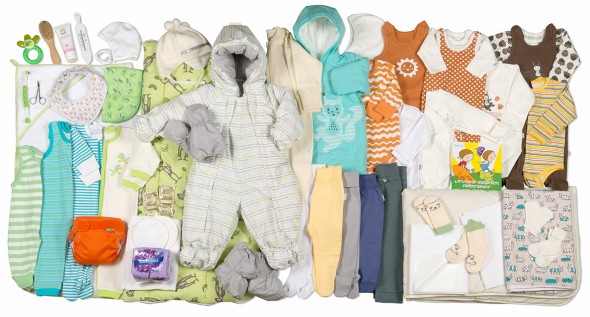
Contents of the Finnish baby-box. Photo: Annika Söderblom © Kela
Shortly before my first baby was born – ah, all of thirteen years ago, and a bit more – I paid a visit to the baby department of a central London department store.
Surrounded by push-chairs, feeding pillows, milk-expressers, nappy bins, nappy sacks, pink baby-grows, blue baby-grows, and advice books of every persuasion, I felt bewildered. The choice seemed infinite. Surely it couldn’t be this complicated.
I picked up one of the books. ‘6:30 Get up with your baby.’ I don’t think so, I objected inwardly. I’ve never been an early bird. ‘7:30 Breakfast: toast and marmalade.’ Definitely not. No one was going to tell me what to eat, or when. Were they? What on earth was this brave new world of motherhood going to be like? More…
Hare-raising
13 February 2015 | Reviews
In this job, it’s a heart-lifting moment when you spot a new Finnish novel diplayed in prime position on a London bookshop table – and we’ve seen Tuomas Kyrö’s The Beggar & The Hare in not just one bookshop, but many. Popular among booksellers, then – and we’re guessing, readers – the book nevertheless seems in general to have remained beneath the radar of the critics and can therefore be termed a real word-of-mouth success. Kyrö (born 1974), a writer and cartoonist, is the author of the wildly popular Mielensäpahoittaja (‘Taking umbridge’) novels, about an 80-year-old curmudgeon who grumbles about practically everything. His new book – a story about a man and his rabbit, a satire of contemporary Finland – seems to found a warm welcome in Britain. Stephen Chan dissects its charm
 Tuomas Kyrö: The Beggar & The Hare
Tuomas Kyrö: The Beggar & The Hare
(translated by David McDuff. London: Short Books, 2011)
Kerjäläinen ja jänis (Helsinki: Siltala, 2011)
For someone who is not Finnish, but who has had a love affair with the country – not its beauties but its idiosyncratic masochisms; its melancholia and its perpetual silences; its concocted mythologies and histories; its one great composer, Sibelius, and its one great architect, Aalto; and the fact that Sibelius’s Finlandia, written for a country of snow and frozen lakes, should become the national anthem of the doomed state of Biafra, with thousands of doomed soldiers marching to its strains under the African sun – this book and its idiots and idiocies seemed to sum up everything about a country that can be profoundly moving, and profoundly stupid.
It’s an idiot book; its closest cousin is Voltaire’s Candide (1759). But, whereas Candide was both a comedic satire and a critique of the German philosopher and mathematician Gottfried Wilhelm Leibniz (1646-1716), The Beggar & The Hare is merely an insider’s self-satire. Someone who has not spent time in Finland would have no idea how to imagine the events of this book. Candide, too, deployed a foil for its eponymous hero, and that was Pangloss, the philosopher Leibniz himself in thin disguise. Together they traverse alien geographies and cultures, each given dimension by the other. More…
New from the archives
13 February 2015 | This 'n' that
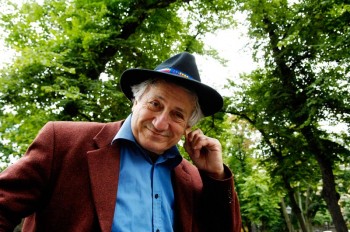
Daniel Katz. Photo: Veikko Somerpuro/WSOY.
In the midst of today’s richly cosmopolitan literary scene – we’re thinking of blockbusters like Sofi Oksanen’s Puhdistus (Purge, 2008), or Patjim Statovci’s Kissani Jugoslavia (‘My cat Yugoslavia’, 2014) (linkit) – it’s hard to imagine the colour and excitement represented by the work of Daniel Katz (born 1938) from the publication of his first book, Kun isoisä Suomeen hiihti (‘When grandfather skied to Finland’, 1969) onward. Characterised by dark humour, gentle irony, a wild imagination and a profound world view, Katz’s writing is informed but never defined by his outsider status as a Jew writing in Finnish.
Today’s story, taken from Katz’s book Talo Sleesiassa (‘A house in Silesia’) describes the journey taken by Erwin, a German Jew, to visit the home he lived in before the Second World War. Katz has a fine grasp of the ironies of history:
‘We arrived at the city of his birth, which currently is referred to as The City, for the sake of simplicity and tact: the town has – used to have, rather – two names, a German and a Polish, and one or the other party might take offence. My brother-in-law had in fact been born in a city whose name began with a B, though now it began with a W. Evolution of this kind is called phonetic history.’
The extract is accompanied by an interview of Daniel Katz by Daniel Katz.
*
The digitisation of Books from Finland continues apace, with a total of 356 articles and book extracts made available online so far. Each week, we bring a newly digitised text to your attention.
Réka Király: Yksi vielä [One more]
11 February 2015 | Mini reviews, Reviews
 Yksi vielä
Yksi vielä
[One more]
Kuvitus [Ill. by]: Réka Király
Helsinki: Etana Editions 2014. 32 pp., ill.
ISBN 978-952-7105-01-6
€17.90, hardback
Réka Király, born in Hungary in 1977, has previously collaborated with fellow illustrator Marika Maijala. Her bright, harmonious fields of primary-colours are well suited to a story influenced by simple folk narratives that tells of animals coming one by one to stay in an uninhabited small cabin. As expected, the cabin creaks and cracks and finally breaks into a million pieces that fly into the air. Kiréaly’s simplified animal characters are very sympathetic. Yksi vielä is a good example of a picture book that develops a child’s sense of image and shape through clever visual inventiveness.
Translated by Lola Rogers
Suvi-Tuuli Junttila: Minne matka, lapanen? [Where are you going, little mitten?]
11 February 2015 | Mini reviews, Reviews
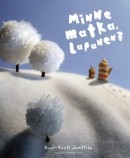 Minne matka, lapanen?
Minne matka, lapanen?
[Where are you going, little mitten?]
Kuvitus [Ill. by]: Suvi-Tuuli Junttila
Helsinki: Schildts & Söderströms, 2014. 57 pp., ill
ISBN 978-951-52-3420-9
€19.90, hardback
Lilla vanten
[Little mitten]
Kuvitus [Ill. by]: Suvi-Tuuli Junttila
Ruotsinnos [Translated into Swedish]: by Jonna Brander
Helsingfors: Schildts & Söderströms, 2014. 57 pp., ill.
ISBN 978-951-52-3460-5
€19.90, hardback
Suvi-Tuuli Junttila’s book combines assemblages and miniatures with winning originality. The exciting journey of the mitten, acorn and bottlecap from autumn to a new spring will inspire creative play and allows young readers to see everyday wonders from a new point of view. Illustration has always been more important than writing for designer and graphic artist Junttila (born 1979) – it is the pictures’ job to create their own story for the viewer. She always places her illustrations in the starring role and gives the text the task of suggestion. Junttila’s previous picture book, Missä, tässä, jossakin (‘Where, here, somewhere’, 2011) won first prize in the Mikkeli illustration triennial.
Translated by Lola Rogers
Iconic Inha
5 February 2015 | This 'n' that
From time to time we have featured the charismatic photographs taken of Helsinki by I.K. Inha (1865-1050) in 1908 – most recently in a book pairing Inha’s iconic images with contemporary photographs of the same scenes by Martti Jämsä (2009). Fifty-one of the images have now been made available online to the public for the first time on the Finnish Museum of Photography’s Flickr page.
Many of the scenes are so little changed that it’s a shock to see them peopled with behatted gentlemen and ladies in long skirts. Commissioned for Finland’s first travel guide, the photographs show the handsome buildings, parks and seafronts of a solidly bourgeois looking city that is still the capital of a Russian province, an autonomous Grand Duchy actively fostering the dream of independence that is to be realised nine years later, in 1917.

Student Union Building on Itäinen Heikinkatu (now Mannerheimintie). I.K. Inha, 1908.
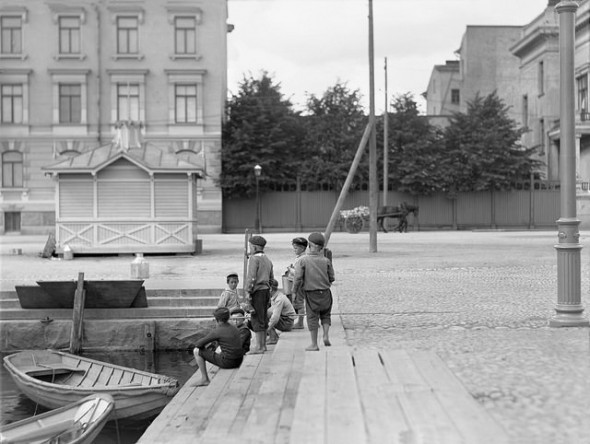
Boys at Hietalahti harbour. I.K. Inha, 1908.
